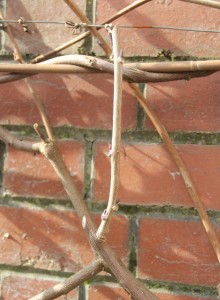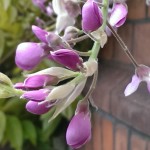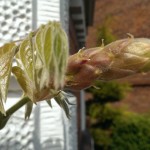08 Oct The Pause…Today; Wisteria: 5 Rules for Success
Wisteria: Success with Flowering
Five Rules for Wisteria Success
1. Sunshine
2. Good plant selection
3. Provide support
4. Trim
5. Nutrition
1. SUNSHINE
Wisterias require sunshine a minimum of 6 hours to encourage flowers.
Best position is South facing, Southwest facing or a sheltered South East facing location.
Take time to select your planting location, once established the plant will be too large and dependant on its support to be relocated.
Plant in a well prepared hole conditioned with rich organic compost or well rotted manure.
Ensure that the top of the root ball is planted level with the garden soil surface.
Water for the first year, continue to water if the following year is dry.
I initially tried a sheltered East corner of the garden but finally relented and moved my young plant to its current South facing home, it is very happy, flowering in its third year.
2. GOOD PLANT SELECTION
Always opt for a named variety from a reliable nursery.
Always select a grafted Wisteria that is propagated from a prolific flowering parent plant. A reputable nursery will always be happy to discuss your choices. Once planted they will usually flower within three to five years, or sooner.
For extra reassurance buy your Wisteria in May while it is in flower, you will know what you are getting.
Large specimens in bloom will cost more but you are unlikely to wait years before it blooms.
Plants grown from seeds/unnamed seedlings or plants grown directly from the rootstock could take up to thirty years to bloom and even then produce stunted flower displays with poor colour!
3. PROVIDE SUPPORT
Wisteria’s natural habitat is in a wood twining up the trees for support, you will need to provide support.
A series of horizontal sturdy guide wires attached to a sunny wall at approximately 30cm intervals. Or
A free standing frame/structure put in situ before the plant gets large.
4. TRIM WISTERIAS SUMMER AND WINTER 
Each August trim young whippy stems that appear from the main stem.
Count 6 leaf buds from the main stem to the whip tip and trim on a slight diagonal 2cm past leaf bud.
In January the plant is dormant and you will be able to see what you are doing, horizontally tie in any stems you want to train as part of the plant’s framework.
When tying in stems ensure they are tied in the correct clockwise direction, or the plant wastes energy correcting itself.
In January you will be reducing August’s trim; from 6 leaf buds to 2 or 3 leaf buds counting and cutting from the main stem as before.
Cut whippy growth growing from the base of the plant at source.
With pruning the best Wisteria varieties will always deliver.
CHINESE WISTERIA : WISTERIA SINENSIS
CHINESE Wisteria twines ANTI-CLOCKWISE
Wisteria sinensis flowers before the leaves emerge, making a dramatic display.
Suggestions to grow:
Wisteria sinensis ‘Prolific’ produces showy mauve/blue blooms.
Wisteria sinensis ‘Amethyst’ produces showy mauve/blue blooms.
Wisteria sinensis ‘Jako’ has white blooms.
JAPANESE WISTERIA : WISTERIA FLORIBUNDA
JAPANESE Wisteria twines CLOCKWISE
Wisteria floribunda varieties flower later, with the emerging leaves, producing longer blooms/racemes.
Suggestions to grow:
Wisteria floribunda ‘Alba’ produces white pretty pendulous lacey racemes.
Wisteria floribunda ‘Rosea’ produces long pink racemes which look gorgeous against the emerging coppery green foliage, it certainly compliments the clay brick wall it sits on.
Wisteria floribunda ‘Yae-Kokuryu’ also known as Wisteria ‘Black Dragon’ produces striking violet/blue blooms.
5. NUTRITION
Roots – Wisteria’s natural environment is a cool moist slightly acidic forest floor in deep leaf litter.
Stems/foliage/flowers – will always seek the sunshine, a minimum of 6 hours per day.
If required a dressing of Iron Sulphate will help alkaline soil towards an acid pH.
Food – Top dress the plant’s base in spring with well rotted manure or organic compost. Important note: manure must be well rotted fine crumb texture, or it will cause harm by burning the plant’s new growth.
Spring feed – apply Growmore, a general feed, in the spring – follow manufacture’s instructions.
For extras an application of Liquid Tomato feed every 14 days during the spring growth until May, will support flower growth.
Once established Wisteria are happy to be left, receiving the occasional spring feed.
TRAINING A YOUNG WISTERIA
Year 1. After planting:
Trim the leading shoot of your Wisteria back to approximately 90cm above ground level and remove any side stems; this will encourage a strong new leader to form.
Tie the leader in vertically and choose two new whippy side stems, left and right of the leader.
Gently tie these horizontally onto the wires.
Trim all smaller whippy shoots coming from these side stems to two or three leaf buds.
Gently untie the side stems and prune them back by about a third, then re-tie.
Year 2.
Tie in the leader as it grows and choose two strong side stems to form the next tier.
These should then be tied in horizontally repeating the process from the previous year.
Trim established side stems to about a third of their total length.
ADDITIONAL YEARS
Each following year provides the opportunity to create a tier. Continue until the desired height and spread is reached, keep tying in the side stems as they spread out.
Each August, cut back the whippy new growth on all side stems to six buds counting from the main branches.
Each January, cut back these stems even harder to within two or three buds of the main branches.
These form the short spurs that produce the flowers in the following spring.
Continue trimming as per established Wisteria refer to ‘TRIM WISTERIAS SUMMER AND WINTER’.
Note: All parts of a Wisteria are toxic if eaten.
Wishing everyone happy Wisteria success.





Sorry, the comment form is closed at this time.